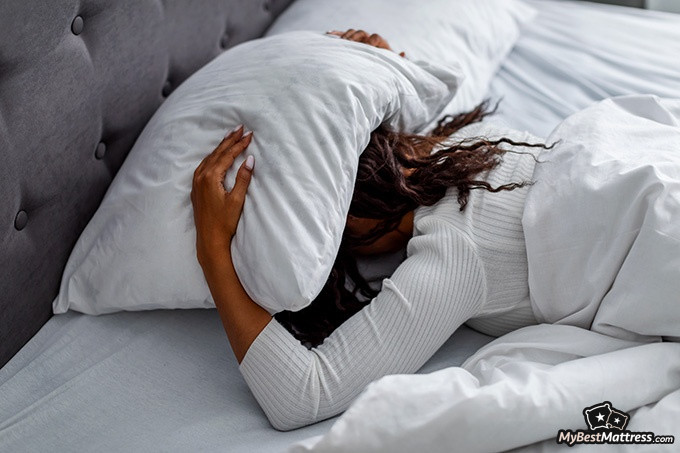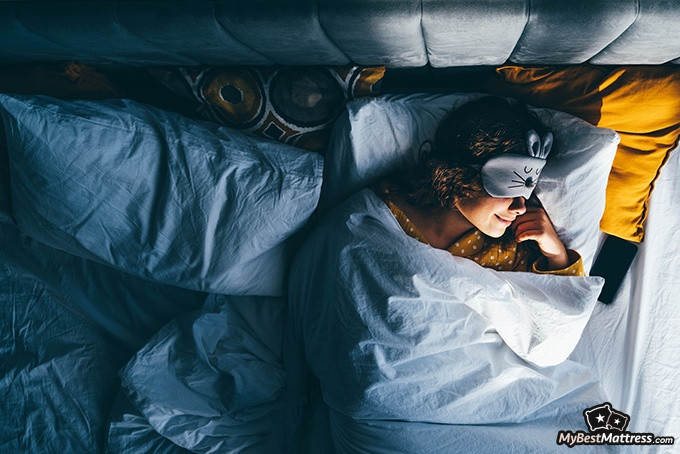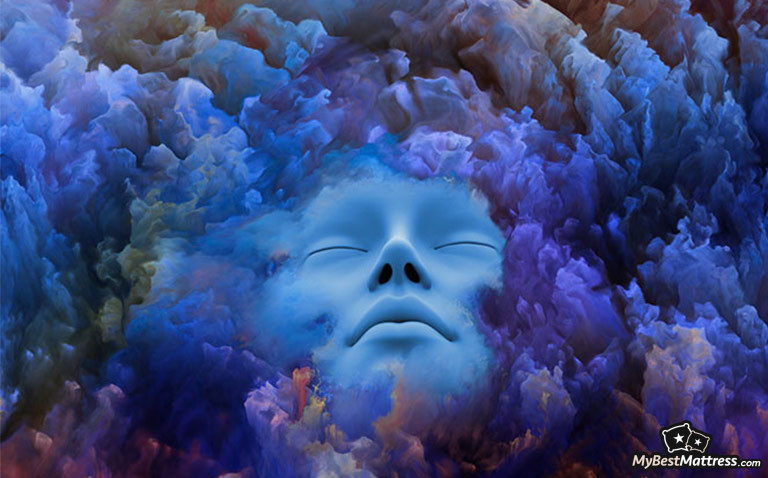
It might surprise you, but the sleep disruption you or your child have experienced may not be what you think it is. In fact, depending on the symptoms, health, and even the sleeper's age, it may be one of two very common sleep disorders — night terrors vs nightmares.
Imagine that you put your child to bed for the night. They seem to be sound asleep. Then suddenly, not long after you’ve left them alone for the night, you hear screaming. You rush to check in on them and find them thrashing around in their bed. After ten or so minutes, it ceases.
When you ask them if they dreamt of something bad or scary in the morning, they can’t recall anything. So, you write it off as a nightmare and keep an eye out on them the following few nights.
However, you wouldn’t be quite right. Such unconscious behavior is a textbook example of a night terror, a different kind of sleep disorder. Nightmares, on the other hand, draw out fewer physical reactions, but the dreamer can remember them vividly.
So, if they’re two different things, there must be more features setting them apart. What are the key differences when it comes to comparing night terrors vs nightmares? How can they affect the sleeper? Do they point towards something worse happening to the body or mind?
Today, we’ll look into the differences between night terrors vs nightmares. We will see who these disorders affect more – children or adults. You’ll also be able to find some suggestions that may help manage the symptoms and see how even small changes – such as using a sleep mask or a weighted blanket – can have a positive influence.
Table of Contents
Night Terrors vs Nightmares: An Overview
You’ve surely heard the terms “night terror” or “nightmare”. And not just in the context of sleep – they can be used to describe scary or unpleasant situations. Some people even use them interchangeably. They sound like they should be synonyms, at the very least.
So, now you might be thinking – aren’t nightmares and night terrors the same thing?
Not at all! While they both fall under a group of sleep disorders known as parasomnia, they’re two very distinct types. They happen at different stages of sleep and exhibit themselves with various symptoms and behaviors.

Parasomnia disorders fall under three different categories – non-REM, REM, and other parasomnias. As the names may suggest, they vary based on whether they happen during non-REM (non-rapid eye movement) or REM (rapid eye movement) sleep, or whether they can happen regardless of the sleep stage.
Since nightmares and night terrors happen at different sleep phases, their symptoms and the sleeper’s behavior vary based on brain activity and depth of sleep. Whether the sleeper can remember their sleep terror or nightmare episode also depends on these factors.
Let's take a closer look at night terrors vs nightmares.
Night Terrors
Night terrors are non-REM sleep disorders. You may also see them referred to as sleep terrors. They are a type of parasomnia that occurs in the early stages of sleep, before muscles tense up and the brain reaches its peak activity.

Witnessing night terrors can be like watching a scene from a horror film. It causes the sleeper an intense physical reaction — they thrash and flail in bed, scream, their limbs move uncontrollably.
Night terrors appear to affect babies and young children the most. According to the DSM-5, night terrors primarily affect children between the ages of 3 to 8. As they grow, this phenomenon becomes less frequent and tends to disappear.
Episodes of night terrors are triggered by an overly aroused central nervous system. However, the exact causes of night terrors in babies and children are generally unknown[1]. While it’s known that children are heavily affected by it and tend to outgrow it quite quickly, the why remains a mystery.

This condition is far less common among adults. In the case of adult night terrors, it can be possible to identify the potential cause. It’s often related to the person’s mental health.
Sleep terrors in adults may point towards trauma, anxiety, or a panic disorder. Disordered eating, illnesses, or migraines can also be among the triggers. Certain genetic factors may cause episodes of night terrors.
It’s not uncommon for people experiencing night terrors to also sleepwalk[2]. Since both night terrors and sleepwalking tend to happen in the non-REM sleep phase, they can overlap. This can make night terrors dangerous to the sleeper’s physical health.
A person experiencing both night terrors and sleepwalking is usually unaware of their surroundings. So, they may run into walls, bump into furniture, or even fall off the stairs. They appear to be inconsolable during an episode, so it can be next to impossible to wake them up.

Seizures or night terrors? This question may arise for some parents when they see their children experience an episode. After all, seizures often happen during sleep. It can be difficult to distinguish between the two.
One important feature that helps tell them apart is that seizures may also occur while the person is awake. Seizures also last shorter – around 5 minutes, while sleep terrors may take up to 20 or even 40 minutes.
In order to be sure of the diagnosis and know what treatment may be necessary, it’s recommended to do a brain exam. An electroencephalogram (EEG) is used to detect brain activity and determine whether the sleeper is experiencing a seizure or a night terror[3].
It’s not uncommon for night terrors to be confused with other sleep disorders. Although night terror episodes happen in the early stages of sleep, they can often be mistaken for typical REM conditions, like the REM sleep behavior disorder or nightmares.
Latest Saatva Coupon Found:
UP TO $500 OFF
Limited-time Saatva Sale
We're sharing a limited-time Saatva mattress discount with our readers! Grab this deal & enjoy your new mattress with huge discounts.
Nightmares
Nightmares are something you might have experienced – and remembered. Since they happen during the dreaming phase of sleep, they’re considered a REM-stage sleep disorder. Instead of having regular dreams, the sleeper may dream of something that causes them to feel discomfort, fear, or dread.
Explaining nightmares as a phenomenon is complicated. Almost as complicated as explaining why people dream at all. While sometimes the triggers are clear, understanding dreams and nightmares is still something of uncharted waters for us.

Nightmares don’t usually cause an intense physical reaction. However, a person experiencing a nightmare may sweat or have an increased heart rate. The sense of dread can follow them once they’ve woken up. It can be difficult to go back to sleep, especially for children.
Unlike with episodes of night terrors, a person may remember a nightmare after waking up. This does not necessarily mean remembering it in detail. The sleeper may simply recall that the anxiety or fear upon waking up was caused by a nightmare.
There is no single clear cause for nightmares. It may be influenced by factors like age, social environment, stress, mental health, or sleep quality, among others. A nightmare can be triggered by watching a scary film or having a fever. Overeating, getting drunk, or using certain medications can also cause nightmares.
Nightmares are common among all age groups. It’s not unusual for adults to experience bad dreams. However, as with night terrors, they appear to be more common among young children.

Hallucinations can sometimes be confused with nightmares. Hallucinations typically happen either as you fall asleep or as you wake up. They can blur with reality more and leave you feeling confused rather than anxious.
It’s possible to determine whether nightmares are recurring or a one-off sleep disturbance. A person is experiencing a recurring nightmare if the same or similar images disturb their sleep more than once.
Recurring nightmares can happen at various points in life. You might hear stories of people having nightmares about coming to an exam room unprepared years after finishing high school.
In some cases, nightmares can become chronic. This is often related to increased stress levels and anxiety. Nightmares are considered chronic if they happen at least once a week.

If nightmares persist, sleepers — particularly children — can get scared of going to sleep. This time of day becomes associated with dread, so a person might try to avoid sleeping for as long as possible. This can lead to sleep deprivation or even insomnia[4].
A nightmare, vs a night terror, may be easier to find the root cause for and treat. In many cases, treatment may not be necessary at all.
Nightmare vs Night Terror: What’s the Cause?
As we can see, night terrors vs nightmares affect the sleeper in different ways. However, as unexplored as the causes for these disorders may be, there can be some common causes between the two.
The causes of various sleep disorders, including nightmares and night terrors, are still being explored by researchers. They can be age-dependent or genetic[5]. However, there are also outside factors that could be contributing to these conditions.

A nightmare, vs a night terror, can have a broader, more clearly defined spectrum of triggers. Some of the potential causes for nightmares can be:
- Age
- Active imagination
- Genetics
- Response to a scary event (movies, games, books, etc.)
- Illnesses and fatigue
- Headaches and migraines
- Medication side effects
- Alcohol or drug use
- Overeating or eating before sleep
- Stress and anxiety
- Post-traumatic stress
- Sleep deprivation and other sleep-related disorders (sleep apnea, narcolepsy)
It can be harder to understand why a child is experiencing a nightmare. For babies and toddlers, it’s presumed to be a natural part of the sleep cycle. Often, nightmares can be caused by a vivid imagination.
As a child grows older, nightmares may be triggered by stress at school or at home. They can be affected by movies or games. In general, nightmares tend to go away once the stress factor is removed. However, if they persist, a doctor should be consulted.
It’s recommended that children do not watch movies or play games that could have scary or disturbing images, especially just before bedtime. The feelings of fear can follow them into dreamland and cause nightmares.

How we feel when we’re awake can affect the way we sleep. So, feeling ill or being in pain can make you sleep worse. That being said, some medications can cause hallucinations or even nightmares as side effects, so you should keep an eye out on how they might affect you as well.
Migraines may trigger a number of physical and mental discomforts[6]. Physical pain in your head can mess with your sleep quality and cause you to have unpleasant dreams. It can be hard to fall asleep, and the dreams in the REM stage may cause even more discomfort.
Sometimes the situation can be flipped — bad dreams, especially recurring nightmares, can lead to a lack of rest and sleep deprivation. This, in turn, can force the sleeper to wake up with an intense splitting headache.

Eating and drinking have been shown to be among the causes of nightmares. Too much eating and drinking close to bedtime, to be exact. Since the digestive system slows down while we sleep, physical discomfort can lead to bad dreams.
Removing the stressor usually resolves the issue. However, in some cases, nightmares may require more intervention. Nightmares can cause a person to relive traumatic experiences. If these nightmares become chronic, they can negatively impact the overall quality of life, cause exhaustion and additional stress.
The causes for night terrors, vs. nightmares, are harder to determine[7]. Researchers have not yet found out what causes night terrors in young children. This can be particularly scary for parents, as it can be harder to figure out what changes to make or how to help their child.

Here are a few potential reasons for night terrors:
- Genetics
- Illness
- Restless leg syndrome
- Fatigue and sleep deprivation
- Medication
- Trauma and PTSD
- Depression and anxiety
- Substance abuse
It’s assumed that there could be a genetic factor to night terrors. Family history of sleepwalking or night terrors could be a factor. Restless leg syndrome has also been associated with various parasomnia disorders. Treating it appears to help alleviate other sleep conditions[8].
Night terrors can be brought upon by overall bad sleep quality. If a baby or a toddler is fussy and not getting enough sleep, they may experience episodes of sleep terrors. Teething causes pain and discomfort that could also lead to unwanted sleep problems.

In adults, night terrors tend to be caused by sudden emotional changes. Increased stress, anxiety, bouts of depression are among possible triggers.
Persistent night terrors in adolescence and adulthood may point to psychological issues. Night terrors tend to be linked with psychological trauma and could be a sign of post-traumatic stress disorder (PTSD)[9].
As we can see, even in the case of night terrors vs nightmares, both conditions seem to be closely tied to possible mental health decline. This isn’t surprising. Our brains process the day’s events during sleep, so changes in mood and the brain’s chemical balance can strongly affect our rest.

Traumatic experiences, both in childhood and adulthood, stand out as potential causes for both when we’re talking night terrors vs nightmares. People who went through abusive situations might relive these experiences in their nightmares or react adversely to being touched during a night terror episode.
So, while the causes of nightmares, and especially night terrors, have not yet been fully explored, it’s possible to figure out what might affect them more. In order to be assured, it’s always recommended to consult a professional. They can help you to look into the causes of your sleep disorder and figure out the next steps.
Treatments
While the disorders themselves differ quite a bit, the treatments of night terrors vs nightmares aren’t all that different. The experiences can be very personal, especially for those suffering from trauma-related sleep disorders. However, people dealing with either nightmares or night terrors can take similar actions to help alleviate their conditions.

Nightmares in children can often be linked to active imagination. It might be best to avoid things that could make their fantasies go a little haywire. So, intense, flashing animations or exciting video games should probably be saved for earlier hours of the day[10]. While kids’ bad dreams can be unpredictable, they don’t necessarily point towards something worse.
Thankfully, the prognosis for night terrors in children is positive. They tend to outgrow the condition and usually don’t experience episodes later in life. Often, the most important thing that the parents may need is reassurance that this isn’t a permanent problem.
So, nightmares and night terrors in children tend to disappear over time. However, that doesn’t make the experience any less scary. Parents may still want to take some steps to make sure the episodes aren’t as frequent or severe.
Usually, simply reassuring the child that they are safe and what they experienced is just a bad dream can be enough. However, you should also keep track of when and for how long your child sleeps.

Depending on their age and schedule (if they go to a kindergarten or school), they might not be getting enough sleep. Napping, earlier bedtimes, and even trying out the biphasic sleep model could all help make sure your child is sleeping enough.
If episodes of night terrors worry you, you can consult a doctor. They may recommend conducting a sleep study or give individual advice based on your child’s sleep habits. For more persistent cases, a personalized treatment plan can be applied.
For both nightmares and night terrors caused by traumatic experiences or mental illness, therapy is recommended. Cognitive-behavioral therapy (CBT) or Eye Movement Desensitization and Reprocessing (EMDR), along with medication, have been proven to be effective in treating distressing sleep disorders.
A consultation with a nutrition expert can help figure out correct eating habits to avoid nightmares brought upon by a food coma. If you believe that alcohol or other substances influence your quality of sleep, you may also want to get in touch with a professional to work on these issues.

Since media can be a strong trigger for nightmares, it’s recommended to avoid blue screens before sleep. This means phones, laptops, or tablets should be put away about an hour before bedtime.
If a person isn’t sure whether they’re experiencing night terrors or seizures, reducing visual triggers could be a good idea. They may want to get a sleep mask to shield their eyes. Reducing outside stimuli before or during sleep may decrease the risk of overstimulating the nervous system.
If the nightmares or night terrors aren’t persisting and seem to be a once-in-a-blue-moon occurrence, the simplest way may be just to wait it out. If you’re going through a stressful period, it’s possible the problems will be resolved once you’re able to relax again.

So, even if the causes of night terrors and nightmares are muddy, there are active steps you can take to recover. Whether it’s medical, therapeutic, or simply requires you to be a little patient – a sleep disorder is something that can be worked on.
How to Avoid Nightmares and Night Terrors in the Future?
The prospect of nightmares and night terrors recurring is scary. There’s no guarantee that they won’t make a grand reappearance one day. However, there are steps you can take to try and reduce the risk.
Whether it’s night terrors vs nightmares, taking care of your mental health can be the correct answer. While mindfulness, meditation, or yoga may not be a cure for a sleep disorder, they can help you remain calm, manage stress, and relax your mind before sleep.

In the long term, therapy methods like CBT or EMDR can help manage depression or anxiety. If you are dealing with PTSD, it’s possible to work on managing triggers and symptoms that can directly affect your sleep.
Where you sleep has probably the most direct influence on how you sleep. You should make sure that you don’t use your bed for anything other than sleep. This reduces the number of stressors your brain associates with sleep.
It’s important to keep the sleeping area clean and secure. Remove any sharp or potentially dangerous items, cover pointy corners. In the case of sleepwalking, it’s crucial to reduce the risk of injury.

Additional weight on the sleeper can help keep pressure on the body and alleviate night terrors, nightmares, and other sleep disturbances. While research about the usefulness of weighted blankets in treating sleep disorders has focused primarily on children with autism, they can help neurotypical children and adults as well.
Sleep is a particularly delicate subject when it comes to infants. Sudden infant death syndrome (SIDS) is a lurking risk that can occur during sleep. So, making sure that the baby is sleeping safely and comfortably is crucial.
For this, parents should look into mattresses designed specifically for cribs. They’re created to support the growing body and alleviate possible discomforts during sleep, like sudden temperature changes. While a mattress cannot eliminate the risk of SIDS or night terrors, it can provide physical comfort for the baby and allow them to sleep easier.

A new, comfortable mattress may be just as helpful for children and adult sleepers experiencing sleep disorders. It’s possible that you’re sleeping a little too firm, too soft, or too warm, causing your night terrors or nightmares to grow more aggravated.
Try flipping things around. If you’re currently sleeping soft, look into a firmer mattress. Vice versa, if you feel like a firm mattress is making your sleep worse, consider investing in a softer mattress.
Many of the biggest names in the industry, like Saatva, Puffy, and Layla, offer flexible return policies, allowing you to try out the product before settling on it for good.
There is no guarantee that nightmares or night terrors won’t reappear during your sleep ever again. However, with these strategies, you may already be prepared to act if you feel unwanted sleep disorders disrupt your nights again.
Summary
When it comes to figuring out if what you’re experiencing is a night terror vs a nightmare, there are a few things to keep in mind.
Firstly, night terrors are experienced mostly by children, but in rare cases, adults can experience them, too. A sleeper will start flailing around, screaming, shaking their limbs uncontrollably for around 10 minutes, although sometimes it can last for the better part of an hour.

A person experiencing a night terror, vs a nightmare, does not remember it when they wake up. In some cases, a person might start sleepwalking during a night terror. The causes for night terrors are relatively unknown. However, adults might experience them due to stress or trauma.
Night terrors could also be confused with night seizures. Since both conditions can last a few minutes and happen during sleep, it’s hard to tell them apart without medical testing.
Nightmares are more common in children but they are experienced by sleepers of all ages. Bad dreams happen during the REM stage of sleep, and the sleepers often remember the nightmare they had and the feeling of fear or dread it left behind.

It’s easier to figure out what triggered a nightmare vs a night terror in adults. They can be related to stress, lack of sleep, fatigue, or illness, among other causes. Depression or anxiety can also impact the quality of sleep and trigger nightmares.
There’s usually little to no need for interference when children experience nightmares or night terrors. They tend to grow out of it. However, it’s important to reassure them that they’re safe when they’ve woken up and that a nightmare was not real.
For adults experiencing nightmares and night terrors, psychotherapy can be helpful. Often, these disorders have psychological roots, so a therapist could help figure out a treatment plan or show how to manage stress and anxiety.

It’s important to make sure that the sleep environment is safe and comfortable for the person experiencing sleep disorders. Try to get rid of nearby dangerous objects. Make sure your mattress is comfortable and provides your body with enough support. Invest in a sleep mask to keep visual triggers or stressors out.
Most importantly — the recovery prognoses for these disorders are optimistic. Children are set to outgrow it. As for adults – stress management, therapy, and, when necessary, medication tend to lead towards a positive outcome.
Conclusions
So, night terrors vs nightmares. Which one’s haunting you?
To figure it out, ask the following questions:
- Can you remember what you were dreaming about?
- Did you wake up feeling frightened or anxious?
- Do you or your family members have a history of sleepwalking?
- Does it look like you were thrashing around in bed or even moving around the room?
If you answered yes to the first two questions – what you’re experiencing is likely a nightmare.
If questions 3 and 4 describe your situation better, it’s more likely to be night terrors.
Experiencing either of the two can be terrifying. Sleep is the time when we have the least conscious control over our bodies. So knowing that it can move around or come up with scary scenarios without our direct input is strange, to say the least.
However, these conditions can be treated with some help — and sometimes even with a bit of your own initiative. So, make sure you work on your wellbeing, wrap yourself up in a comfortable blanket, relax, and, hopefully, you’ll be able to enjoy restful sleep again soon enough!
Scientific References
1. Ngoc L. Van Horn, Megan Street 'Night Terrors'
2. Dominique Petit, Marie-Hélène Pennestri, Jean Paquet et al. 'Childhood Sleepwalking and Sleep Terrors: A Longitudinal Study of Prevalence and Familial Aggregation'
3. Christopher Paul Derry, Margot Davey, Murray Johns et al. 'Distinguishing Sleep Disorders From Seizures'
4. Bryony Sheaves, D Clin Psy, Kate Porcheret et al. 'Insomnia, Nightmares, and Chronotype as Markers of Risk for Severe Mental Illness: Results from a Student Population'
5. Hanna M Ollila, Nasa Sinnott-Armstrong, Katri Kantojärvi et al. 'Nightmares share strong genetic risk with sleep and psychiatric disorders'
6. F. De Angeli, C. Lovati, L. Giani et al. 'Negative Emotions in Migraineurs Dreams: The Increased Prevalence of Oneiric Fear and Anguish, Unrelated to Mood Disorders'
7. Alexander K C Leung, Amy A M Leung, Alex H C Wong et al. 'Sleep Terrors: An Updated Review'
8. Neepa Gurbani, Thomas J Dye, Kyle Dougherty et al. 'Improvement of Parasomnias After Treatment of Restless Leg Syndrome/ Periodic Limb Movement Disorder in Children'
9. Anne Germain 'Sleep Disturbances as the Hallmark of PTSD: Where Are We Now?'
10. Sara Peracchia and Giuseppe Curcio 'Exposure to video games: effects on sleep and on post-sleep cognitive abilities. A sistematic review of experimental evidences'
Leave your honest feedback
Leave your genuine opinion & help thousands of people to choose the best mattress. All feedback, either positive or negative, are accepted as long as they’re honest. We do not publish biased feedback or spam. So if you want to share your experience, opinion or give advice - the scene is yours!













